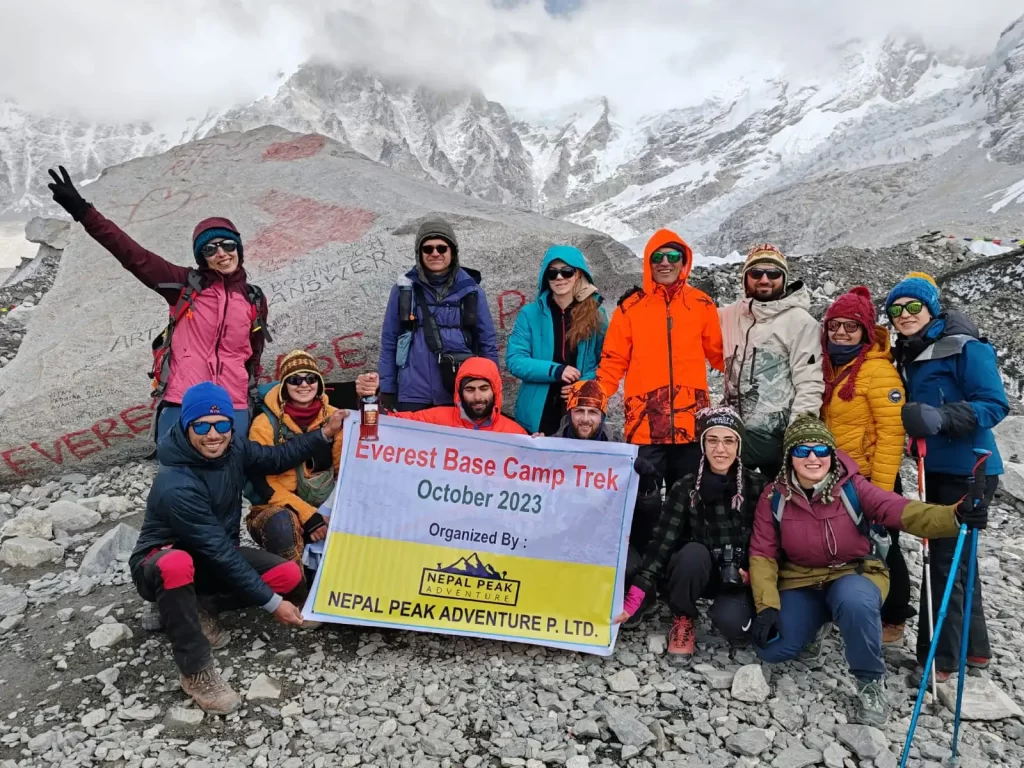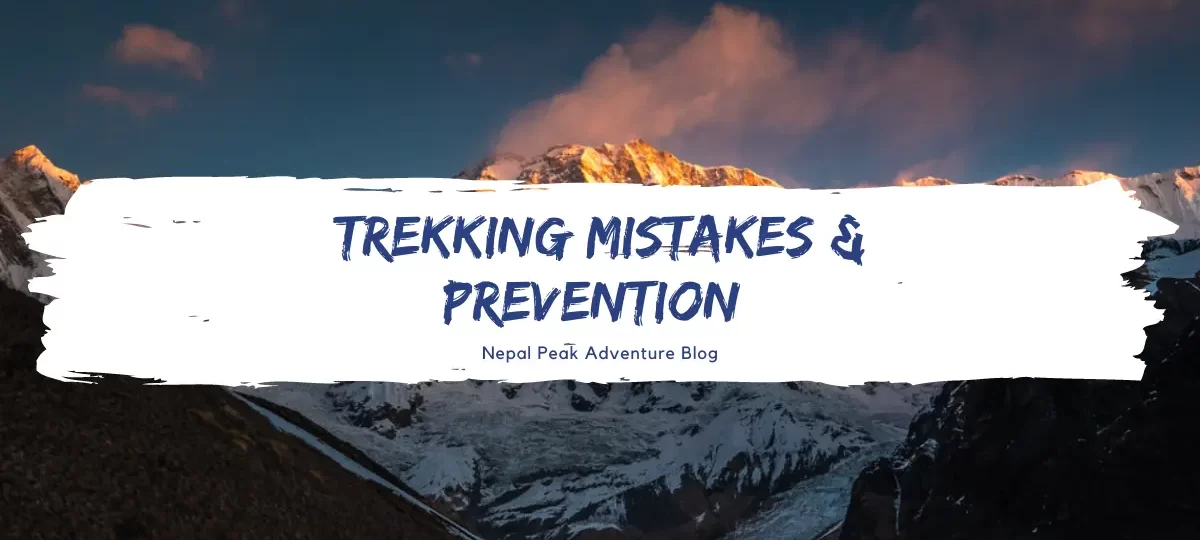Trekking Mistakes and How to Avoid Them: Trekking 101
“Trekking Mistakes and How to Avoid them” is an informational guide for all levels of trekkers. I will try to cover all the common mistakes that trekkers make during the trek and how to avoid them. The goal of this guide is to help trekkers mostly new trekkers they can have a safe and successful trekking experience.
First of all, here is a short paragraph about me. You can skip this paragraph if you want to learn fast. So, I am Mr. Hom Rana, a professional guide and a tour operator. I have been in this trekking field for more than 25 years and recently started the Nepal Peak Adventure company. With more than hundreds of successful trekking experiences in my carrier, I know lots of things about my field. So, to help you who are unknown to trekking, here are some of my great advice. Hope you will learn something today.

The first common mistake that I have seen among trekkers is that they compare hiking and trekking as equal. As a matter of fact, Trekking is far more challenging than hiking and needs better preparation, guides, and many more. If you look at trekking packages in Nepal then you will see that most of the trekking trails are above 4,000m and it is not available in most countries.
Hiking on the other hand is easy to a moderate level which can help you to prepare for trekking trails that are challenging level. Apart from the comparison between hiking and trekking, here are some other common mistakes that trekkers do:
Preparing Late for Trekking:
Preparing late for the trek is a common mistake that trekkers do due to having little information about the trekking trail or carelessness. Lack of preparation can lead to trekkers being at risk and the possibility of injuries. Even if you are fit and fine, you need to prepare separately for trekking. The reason to take trekking seriously is that, after you enter the trekking region, you will be challenging the altitude sickness, rocky trails, harsh weather, extreme coldness, dehydration, hypothermia, and many more.
Fitness preparation and Packing List preparation are the most important things you need to prepare for. If a trekker does not have the right gear, they will not be able to push forward. In summary, preparing late for trekking creates a lot of problems. You should research well and be prepared for your trek to get the best experience.
How to Avoid “Preparing Late for Trekking”?
Here are some tips on how to avoid preparing late for a trek:
- Plan Ahead: Suppose someone recommended you to go to Everest Base Camp Trek which is a popular trek in Nepal. The first thing you need to do is gather all types of information, and make necessary arrangements. It takes a minimum of 3 months to prepare for treks above 5,000m altitude for healthy people. A beginner needs more than 3 months to prepare.
- Get the Checklists: Create a checklist of all necessary gear and clothing that is required for the trek. You can get the checklist from any tour agency in Nepal. After creating the checklists, learn when and how to use those checklists effectively. Add your own comfort gears if you want and check whether you will be comfortable with the gears or not.
- Research the Trail: Research the trail well & familiarize yourself with the terrain, elevation, weather, accommodations, safety, and other key factors. Get professional help from us if you want. Similarly, know your limit and decide which trail to start.
- Be flexible: Having options to adjust your plans, such as changing the trail or modifying the itinerary if necessary. Adding an extra day to your holiday can also help.
- Seek Professional Advice: Always seek help from a guide or tour agency. Do not hesitate to ask for help. If you find it confusing or have doubts about the trail or gear, do not hesitate to ask for help.
Not knowing How to use Navigation
One of the most important tools for trail navigation is a map and compass. It is important to have a detailed map of the area you will be trekking in and to know how to read a map. It does not take time to learn the basics of navigating. You can practice in the field while hiking after learning the basics of navigating. You should know how to use both a map and a compass.
Another important tool for navigation is a GPS device because it can provide the exact location. However, at high altitudes, it can sometimes fail, so you need to rely on a map and compass again. There is a number of people who were lost on the trail. If they had known how to use Navigation then they could have gotten on the right track again.
How to stay safe and avoid getting lost?
In case you get lost, the first thing you need to do is stay calm & think about your options. The first option is to retrace your steps & try to find a way back to the trail. It is very important to carry a personal whistle, flashlight, or any mirror to use as a signal for help. If you can’t find your way back then stay put and wait for help.
Similarly, in times of foggy weather, do not attempt to cross the trail. At high altitudes, the weather can be too cold and you may encounter snow which can erase your trace. The first thing to remember is to get a guide if you are unknown about the trail. Check the weather condition and do not go solo trek during the off-season.
Unable to Prepare for Changing Weather
Unpredictable weather is a common problem in high-altitude areas. Even during Spring or Autumn season, you will face sudden changes in weather. It depends upon you or a guide on how to take appropriate action. Sometimes, you will be stuck in one place for days at the time of bad weather too. However, sometimes it is possible to push forward even during a sudden change of weather but it needs professional guidance. Local guide or porter knows more than anyone about when and how to take appropriate action during those bad weather conditions.
How to prepare for Changing Weather Conditions?
Choosing the best time like mid-Spring or Autumn can reduce the possibility of bad weather. Still, it is important to understand local weather patterns or ask a professional for advice. Similarly, due to the high elevation, the weather is a bit cold and you need to pack appropriate gear & clothing. It is important to pack layers, as the weather can quickly change & you may need to add or remove layers.
If the weather conditions change while on the trail, it is important to stay alert and take appropriate action fast. This may include taking shelter, turning back, or getting help. Also, if possible, check the weather forecast before leaving for the trek.
Packing List Error
Gears & equipment are very crucial to start your trek. When packing gear, you need to choose the fundamentals for the trek which are more practical than expensive. The first thing you need to gear is:
Personal Hygiene Gear: It is hard to get a shower in a high-altitude area and you will be vulnerable to many illnesses if you neglect personal hygiene. It is important to pack some personal hygiene items such as biodegradable soap, toothbrush, sanitizer, towel, water filter & so on.
Warm Gears: Warm clothes are crucial for trekking and it is important to pack in layers. Avoid cotton clothes and always bring comfortable & flexible clothes. Other important warm gear is a sleeping bag & hot water bladder which is important to have a good sleep in high altitudes where the weather will be extremely cold.
Emergency Gears: It is smart to pack some emergency gear to be prepared for any outcomes in the trek. This includes items like a fire starter, a pocket knife, a blanket, a signaling device, a solar charger, or extra batteries. If you are a solo trekker then please do consider these emergency gear.
By following the packing list, trekkers can ensure a safe & comfortable trek. You can get a checklist too.
Checklist for Which Trek?
“A simple guide for you”
Not Knowing When to Solo Trek & Group Trek: Pros & Cons
Trekking solo has its advantages, such as taking decisions, more freedom & flexibility, and the option to walk at your own pace. However, this concept has led other trekkers who are beginners to do the same which is the biggest mistake.
Solo trekking is for professional who have already trekked on that trail many times and knows about the local system. You need to be well-prepared and able to understand the locals. You need to accept the culture of the locals and be quick to get your room as soon as possible. Similarly, you need to be able to adjust to any condition during the trek as a solo trekker.
While on the other hand, a group trek or with trekking agencies is the safest trek you can get. The workload will be divided between trekkers and getting help during emergencies will be easy. Besides that, there are a few trekking trails that you cannot do a solo trek like Manaslu Circuit Trek.
By considering these “trekking mistakes and how to avoid them”, trekkers can have a safe & enjoyable experience.
Want the best offer?
“Best Price & Best Deals“



